Cultural diplomacy of the republic of Korea to Viet Nam
Cultural diplomacy is considered as soft power, which is used by many nations
in the world aiming to increase their influence and position. The Republic of Korea
(RoK) is one of the first nations in the region having success in using cultural diplomacy
to promote its national brand and to confirm its position in the world’s map. Located in
the common influence of the region, Viet Nam is also one of ideal cultural partners of the
RoK due to the cultural similarities and the psychology of "passionate admiration"
Korean culture. Therefore, understanding the RoK’s policy on cultural diplomacy to Viet
Nam is necessary in order to draw valuable experiences during the process of integration
and development of Viet Nam.

Trang 1
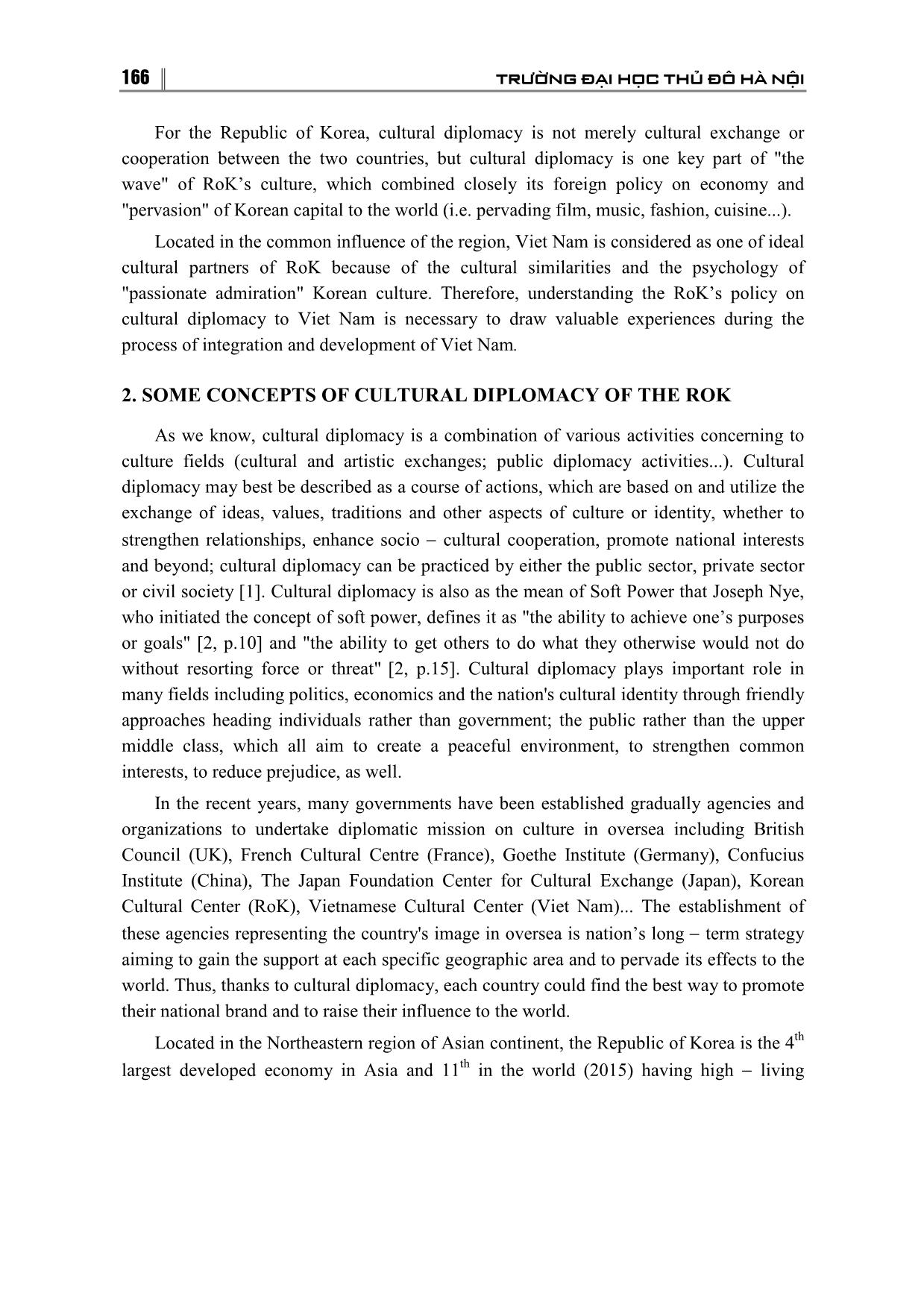
Trang 2
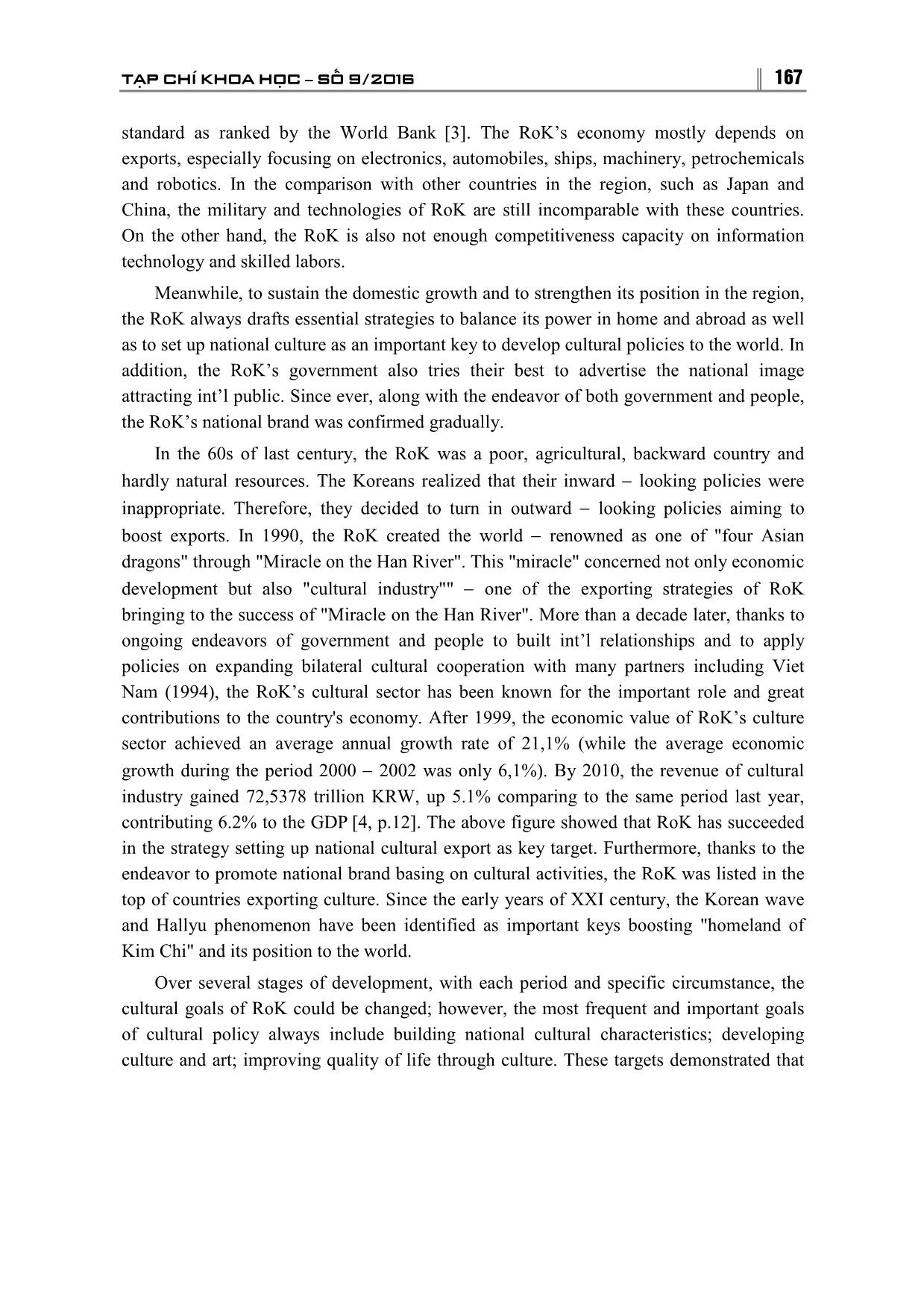
Trang 3
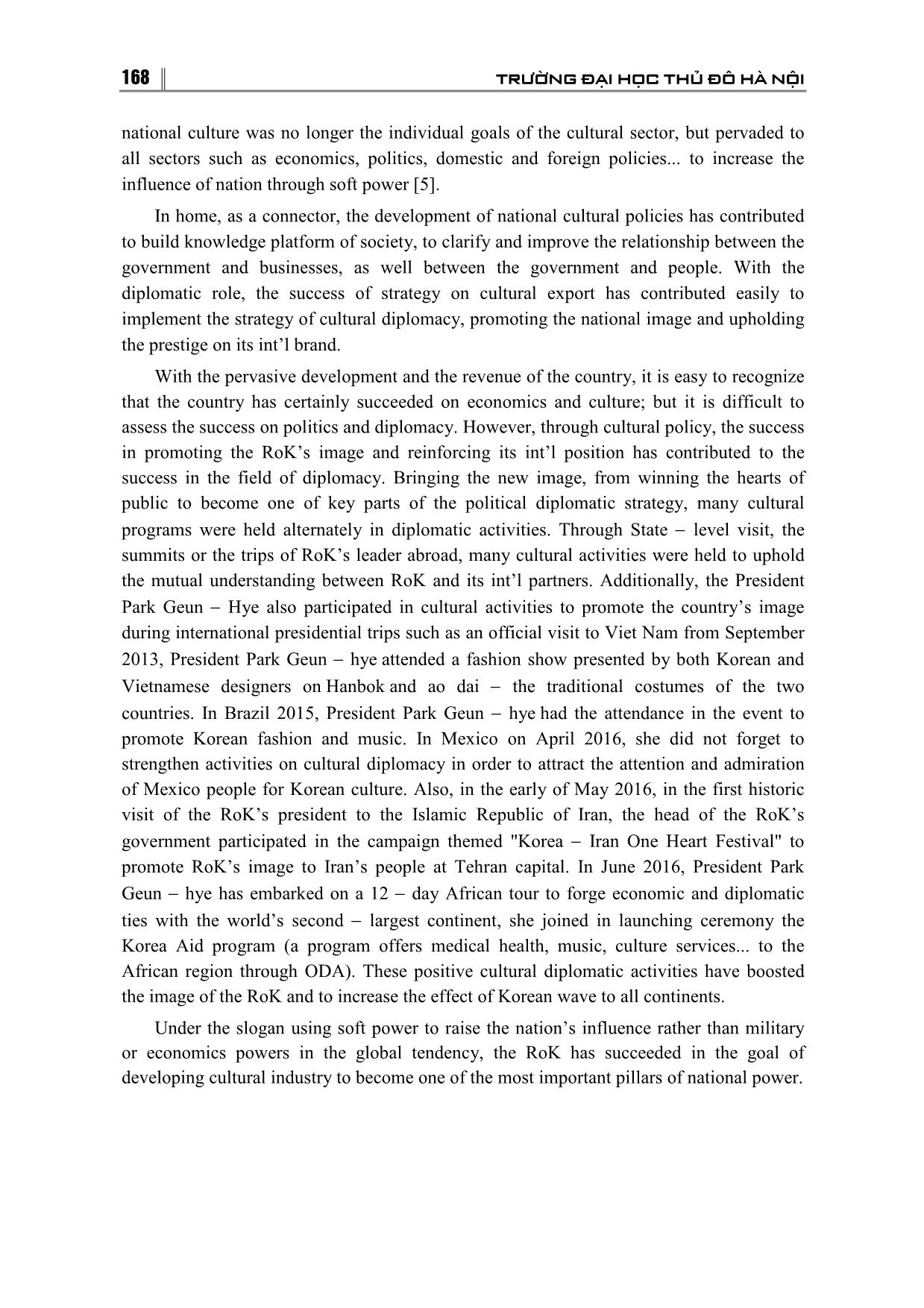
Trang 4

Trang 5
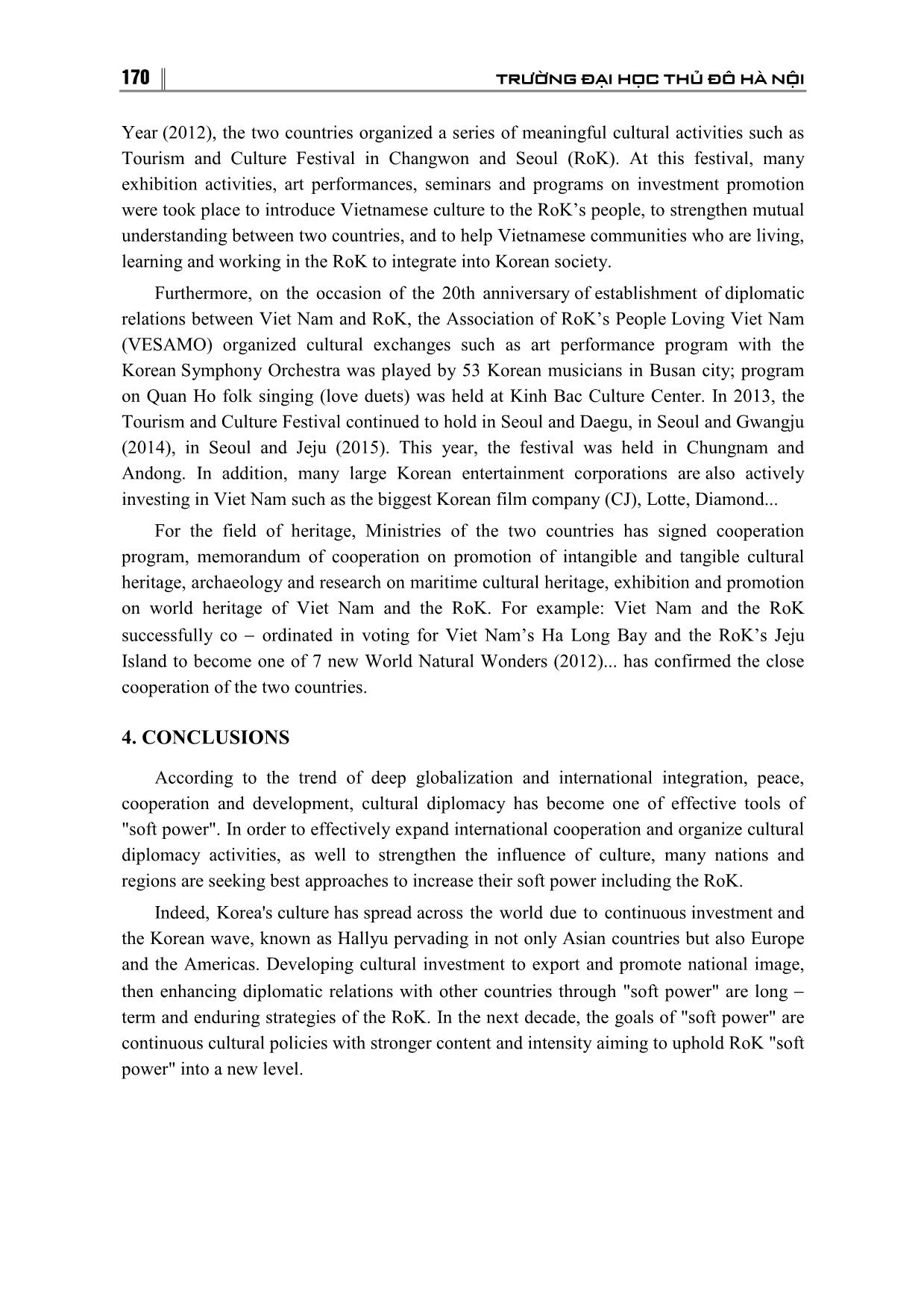
Trang 6
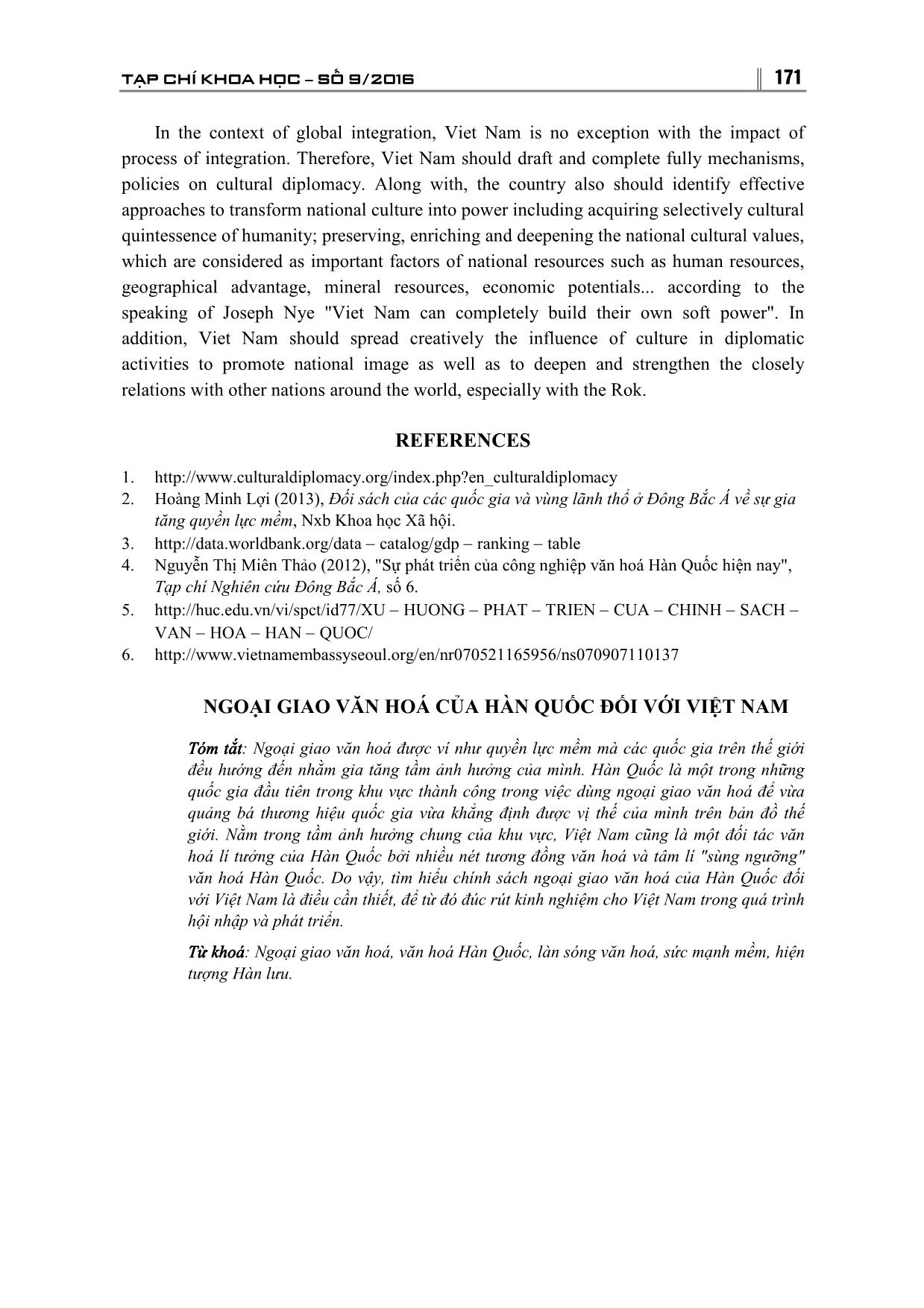
Trang 7
Tóm tắt nội dung tài liệu: Cultural diplomacy of the republic of Korea to Viet Nam
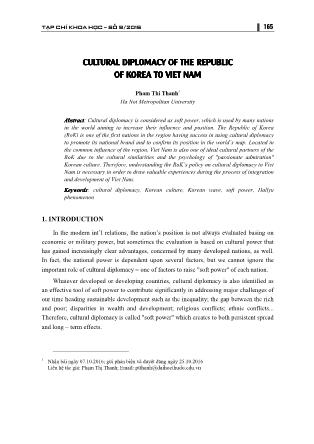
hic area and to pervade its effects to the world. Thus, thanks to cultural diplomacy, each country could find the best way to promote their national brand and to raise their influence to the world. Located in the Northeastern region of Asian continent, the Republic of Korea is the 4 th largest developed economy in Asia and 11 th in the world (2015) having high − living TẠP CHÍ KHOA HỌC −−− SỐ 9/2016 167 standard as ranked by the World Bank [3]. The RoK’s economy mostly depends on exports, especially focusing on electronics, automobiles, ships, machinery, petrochemicals and robotics. In the comparison with other countries in the region, such as Japan and China, the military and technologies of RoK are still incomparable with these countries. On the other hand, the RoK is also not enough competitiveness capacity on information technology and skilled labors. Meanwhile, to sustain the domestic growth and to strengthen its position in the region, the RoK always drafts essential strategies to balance its power in home and abroad as well as to set up national culture as an important key to develop cultural policies to the world. In addition, the RoK’s government also tries their best to advertise the national image attracting int’l public. Since ever, along with the endeavor of both government and people, the RoK’s national brand was confirmed gradually. In the 60s of last century, the RoK was a poor, agricultural, backward country and hardly natural resources. The Koreans realized that their inward − looking policies were inappropriate. Therefore, they decided to turn in outward − looking policies aiming to boost exports. In 1990, the RoK created the world − renowned as one of "four Asian dragons" through "Miracle on the Han River". This "miracle" concerned not only economic development but also "cultural industry"" − one of the exporting strategies of RoK bringing to the success of "Miracle on the Han River". More than a decade later, thanks to ongoing endeavors of government and people to built int’l relationships and to apply policies on expanding bilateral cultural cooperation with many partners including Viet Nam (1994), the RoK’s cultural sector has been known for the important role and great contributions to the country's economy. After 1999, the economic value of RoK’s culture sector achieved an average annual growth rate of 21,1% (while the average economic growth during the period 2000 − 2002 was only 6,1%). By 2010, the revenue of cultural industry gained 72,5378 trillion KRW, up 5.1% comparing to the same period last year, contributing 6.2% to the GDP [4, p.12]. The above figure showed that RoK has succeeded in the strategy setting up national cultural export as key target. Furthermore, thanks to the endeavor to promote national brand basing on cultural activities, the RoK was listed in the top of countries exporting culture. Since the early years of XXI century, the Korean wave and Hallyu phenomenon have been identified as important keys boosting "homeland of Kim Chi" and its position to the world. Over several stages of development, with each period and specific circumstance, the cultural goals of RoK could be changed; however, the most frequent and important goals of cultural policy always include building national cultural characteristics; developing culture and art; improving quality of life through culture. These targets demonstrated that 168 TRƯỜNG ĐẠI HỌC THỦ ĐÔ H� NỘI national culture was no longer the individual goals of the cultural sector, but pervaded to all sectors such as economics, politics, domestic and foreign policies... to increase the influence of nation through soft power [5]. In home, as a connector, the development of national cultural policies has contributed to build knowledge platform of society, to clarify and improve the relationship between the government and businesses, as well between the government and people. With the diplomatic role, the success of strategy on cultural export has contributed easily to implement the strategy of cultural diplomacy, promoting the national image and upholding the prestige on its int’l brand. With the pervasive development and the revenue of the country, it is easy to recognize that the country has certainly succeeded on economics and culture; but it is difficult to assess the success on politics and diplomacy. However, through cultural policy, the success in promoting the RoK’s image and reinforcing its int’l position has contributed to the success in the field of diplomacy. Bringing the new image, from winning the hearts of public to become one of key parts of the political diplomatic strategy, many cultural programs were held alternately in diplomatic activities. Through State − level visit, the summits or the trips of RoK’s leader abroad, many cultural activities were held to uphold the mutual understanding between RoK and its int’l partners. Additionally, the President Park Geun − Hye also participated in cultural activities to promote the country’s image during international presidential trips such as an official visit to Viet Nam from September 2013, President Park Geun − hye attended a fashion show presented by both Korean and Vietnamese designers on Hanbok and ao dai − the traditional costumes of the two countries. In Brazil 2015, President Park Geun − hye had the attendance in the event to promote Korean fashion and music. In Mexico on April 2016, she did not forget to strengthen activities on cultural diplomacy in order to attract the attention and admiration of Mexico people for Korean culture. Also, in the early of May 2016, in the first historic visit of the RoK’s president to the Islamic Republic of Iran, the head of the RoK’s government participated in the campaign themed "Korea − Iran One Heart Festival" to promote RoK’s image to Iran’s people at Tehran capital. In June 2016, President Park Geun − hye has embarked on a 12 − day African tour to forge economic and diplomatic ties with the world’s second − largest continent, she joined in launching ceremony the Korea Aid program (a program offers medical health, music, culture services... to the African region through ODA). These positive cultural diplomatic activities have boosted the image of the RoK and to increase the effect of Korean wave to all continents. Under the slogan using soft power to raise the nation’s influence rather than military or economics powers in the global tendency, the RoK has succeeded in the goal of developing cultural industry to become one of the most important pillars of national power. TẠP CHÍ KHOA HỌC −−− SỐ 9/2016 169 In spite of the fact that the external achievements still did not clearly define, the RoK’s "cultural diplomacy model" almost meets now all the goals of national brand development and maintains positive perception of the world about the RoK. This approach not only brings benefits to Korean communities in oversea but also interprets culture as a bridge to remove barriers of geography and language aiming to enhance and maintain economic, political and diplomatic relationships between RoK and its partners in the future. The RoK is a dynamic country. Besides the outstanding economic achievements, the country has achieved many successes in the field of culture and turned national culture into an industry for exporting. These strategies, experiences and policies on cultural development of RoK are valuable lessons for integration efforts of other countries, including Viet Nam. 3. THE ROK’S ACTIVITIES ON CULTURAL DIPLOMACY TO VIET NAM Located in the East Asia, Viet Nam and the RoK have many historical and cultural similarities. Particularly in the Southeast Asia region, Viet Nam is one of the first countries importing Korean culture in the early period of the RoK’s strategy for exporting culture. In December 1992, Viet Nam and RoK established official diplomatic relations, then signed an agreement on cultural cooperation in 1994. The agreement shall be automatically renewed every five year. Accordingly, the two countries agreed to share management experiences, methods, technique and condition of cultural activities; to implement educational and scientific cooperation; to exchange among arts and culture institutions; to cooperate among literary and artistic associations, writers associations, art associations... These agreements proved that culture was one of fields of cooperation to be seriously considered by the two countries [6]. After the agreement, the number of Korean enterprises invested to Viet Nam increasingly. Along with the volume of Korean cultural imports rapidly also increased, the Vietnamese began to pay attention to the dishes on Korean dramas. Adding it, there was the similarity of culinary culture between Viet Nam and RoK. The family meals always appear rice and anything can be replaced but nothing can replace rice in their meals. Since ever, the interest in Korean foods in Viet Nam has created a basic foundation to advertise Korean cuisine in Viet Nam. In this context, since 2008, the Embassy of RoK in Viet Nam held annually the Culinary Culture Festival Viet Nam – Korea offering colorful booths to advertise Korean cuisine and culture. By 2010, under the support of Korean organizations and agencies, Viet Nam also held annually Tourism and Culture Festival in the RoK. Especially, on the occasion of the 20th anniversary of establishment of diplomatic relations between Viet Nam and RoK and welcoming Viet Nam − RoK Friendship 170 TRƯỜNG ĐẠI HỌC THỦ ĐÔ H� NỘI Year (2012), the two countries organized a series of meaningful cultural activities such as Tourism and Culture Festival in Changwon and Seoul (RoK). At this festival, many exhibition activities, art performances, seminars and programs on investment promotion were took place to introduce Vietnamese culture to the RoK’s people, to strengthen mutual understanding between two countries, and to help Vietnamese communities who are living, learning and working in the RoK to integrate into Korean society. Furthermore, on the occasion of the 20th anniversary of establishment of diplomatic relations between Viet Nam and RoK, the Association of RoK’s People Loving Viet Nam (VESAMO) organized cultural exchanges such as art performance program with the Korean Symphony Orchestra was played by 53 Korean musicians in Busan city; program on Quan Ho folk singing (love duets) was held at Kinh Bac Culture Center. In 2013, the Tourism and Culture Festival continued to hold in Seoul and Daegu, in Seoul and Gwangju (2014), in Seoul and Jeju (2015). This year, the festival was held in Chungnam and Andong. In addition, many large Korean entertainment corporations are also actively investing in Viet Nam such as the biggest Korean film company (CJ), Lotte, Diamond... For the field of heritage, Ministries of the two countries has signed cooperation program, memorandum of cooperation on promotion of intangible and tangible cultural heritage, archaeology and research on maritime cultural heritage, exhibition and promotion on world heritage of Viet Nam and the RoK. For example: Viet Nam and the RoK successfully co − ordinated in voting for Viet Nam’s Ha Long Bay and the RoK’s Jeju Island to become one of 7 new World Natural Wonders (2012)... has confirmed the close cooperation of the two countries. 4. CONCLUSIONS According to the trend of deep globalization and international integration, peace, cooperation and development, cultural diplomacy has become one of effective tools of "soft power". In order to effectively expand international cooperation and organize cultural diplomacy activities, as well to strengthen the influence of culture, many nations and regions are seeking best approaches to increase their soft power including the RoK. Indeed, Korea's culture has spread across the world due to continuous investment and the Korean wave, known as Hallyu pervading in not only Asian countries but also Europe and the Americas. Developing cultural investment to export and promote national image, then enhancing diplomatic relations with other countries through "soft power" are long − term and enduring strategies of the RoK. In the next decade, the goals of "soft power" are continuous cultural policies with stronger content and intensity aiming to uphold RoK "soft power" into a new level. TẠP CHÍ KHOA HỌC −−− SỐ 9/2016 171 In the context of global integration, Viet Nam is no exception with the impact of process of integration. Therefore, Viet Nam should draft and complete fully mechanisms, policies on cultural diplomacy. Along with, the country also should identify effective approaches to transform national culture into power including acquiring selectively cultural quintessence of humanity; preserving, enriching and deepening the national cultural values, which are considered as important factors of national resources such as human resources, geographical advantage, mineral resources, economic potentials... according to the speaking of Joseph Nye "Viet Nam can completely build their own soft power". In addition, Viet Nam should spread creatively the influence of culture in diplomatic activities to promote national image as well as to deepen and strengthen the closely relations with other nations around the world, especially with the Rok. REFERENCES 1. 2. Hoàng Minh L�i (2013), Đ�i sách c�a các qu�c gia và vùng lãnh th� � Đông B�c Á v� s� gia tăng quy�n l�c m�m , Nxb Khoa h�c Xã h�i. 3. − catalog/gdp − ranking − table 4. Nguy�n Th� Miên Th�o (2012), "S� phát tri�n c�a công nghi�p văn hoá Hàn Qu�c hi�n nay", T�p chí Nghiên c�u Đông B�c Á, s� 6. 5. − HUONG − PHAT − TRIEN − CUA − CHINH − SACH − VAN − HOA − HAN − QUOC/ 6. NGO�I GIAO VĂN HOÁ C�A HÀN QU�C Đ�I V�I VI�T NAM Tóm tt�t�t�t�t: Ngo�i giao văn hoá ñư�c ví như quy�n l�c m�m mà các qu�c gia trên th� gi�i ñ�u hư�ng ñ�n nh�m gia tăng t�m �nh hư�ng c�a mình. Hàn Qu�c là m�t trong nh�ng qu�c gia ñ�u tiên trong khu v�c thành công trong vi�c dùng ngo�i giao văn hoá ñ� v�a qu�ng bá thương hi�u qu�c gia v�a kh�ng ñ�nh ñư�c v� th� c�a mình trên b�n ñ� th� gi�i. N�m trong t�m �nh hư�ng chung c�a khu v�c, Vi�t Nam cũng là m�t ñ�i tác văn hoá lí tư�ng c�a Hàn Qu�c b�i nhi�u nét tương ñ�ng văn hoá và tâm lí "sùng ngư�ng" văn hoá Hàn Qu�c. Do v�y, tìm hi�u chính sách ngo�i giao văn hoá c�a Hàn Qu�c ñ�i v�i Vi�t Nam là ñi�u c�n thi�t, ñ� t� ñó ñúc rút kinh nghi�m cho Vi�t Nam trong quá trình h�i nh�p và phát tri�n. TTT�T� khoákhoá: Ngo�i giao văn hoá, văn hoá Hàn Qu�c, làn sóng văn hoá, s�c m�nh m�m, hi�n tư�ng Hàn lưu.
File đính kèm:
 cultural_diplomacy_of_the_republic_of_korea_to_viet_nam.pdf
cultural_diplomacy_of_the_republic_of_korea_to_viet_nam.pdf

